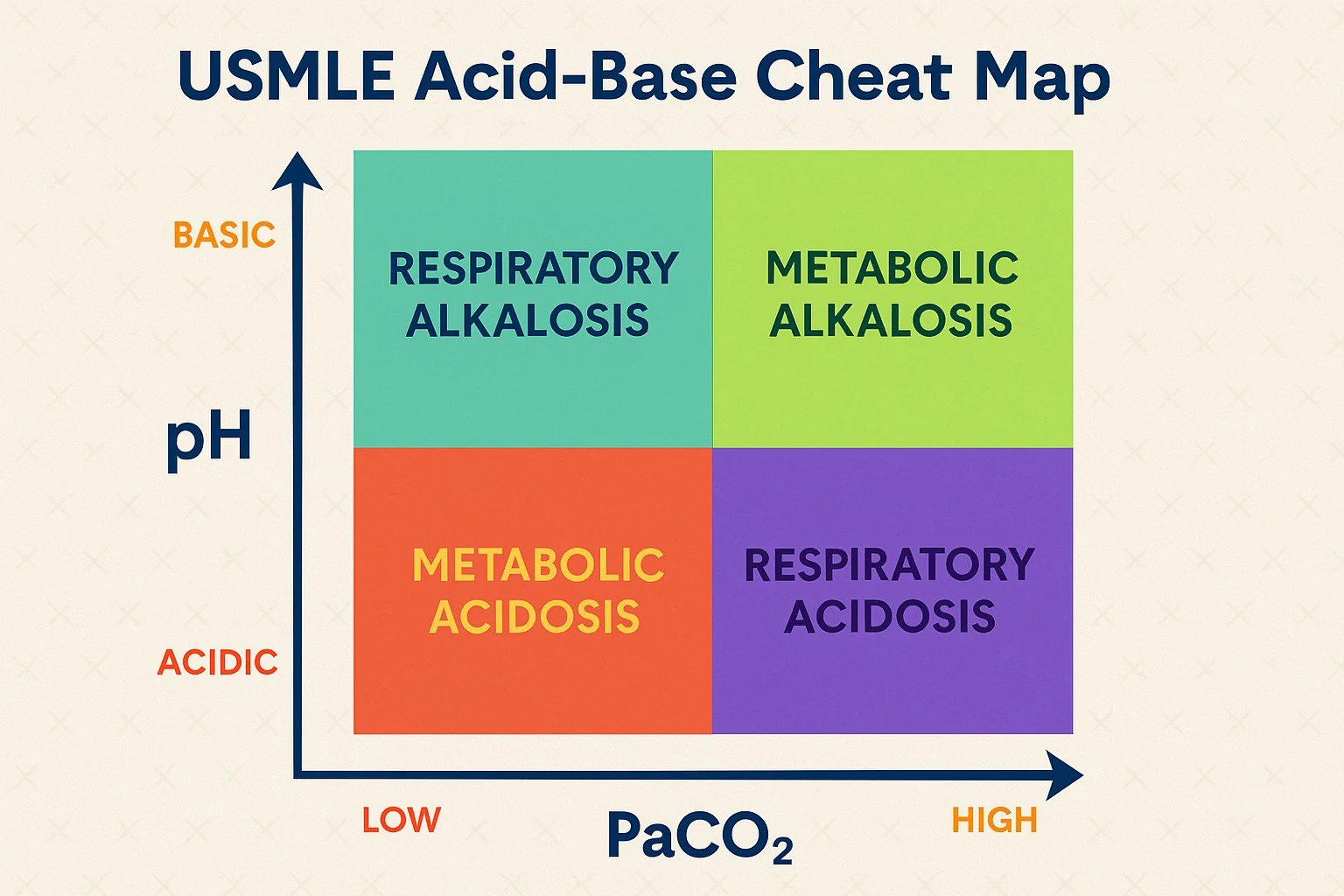Mastering Acid-Base Balance for USMLE Step 1: Quick Guide with Visuals
Acid-base balance is one of those sneaky high-yield topics that finds its way into USMLE Step 1 through various organ systems—respiratory, renal, GI, and even pharmacology. But while the concepts are foundational, students often find interpreting arterial blood gas (ABG) values confusing.
Today, we’ll break down the 4-step approach to decoding acid-base disorders and show you exactly how it appears in Step 1-style clinical vignettes—with one visual to rule them all.
🧪 Why You Must Master Acid-Base for Step 1
It's clinically integrated: Appears in renal, respiratory, and metabolic system questions
It's concept-heavy, not memorization-heavy: Ideal for visual learners
It’s a favorite for tricky two-step clinical reasoning prompts
📌 Example Prompt:
"A 58-year-old man with COPD presents with fatigue and confusion. ABG: pH 7.32, PaCO₂ 52, HCO₃⁻ 28. What's the primary acid-base disorder?"
🔄 The 4-Step Formula to Decode Any Acid-Base Problem
Step 1: Check the pH
pH < 7.35 → Acidosis
pH > 7.45 → Alkalosis
📊 Step 2: Evaluate PaCO₂ and HCO₃⁻
Determine whether the cause is respiratory or metabolic:
| Disorder Type | pH Direction | PaCO₂ | HCO₃⁻ |
|---|---|---|---|
| Metabolic Acidosis | ↓ | ↓ (compensated) | ↓ |
| Metabolic Alkalosis | ↑ | ↑ (compensated) | ↑ |
| Respiratory Acidosis | ↓ | ↑ | ↑ (compensated) |
| Respiratory Alkalosis | ↑ | ↓ | ↓ (compensated) |
Step 3: Assess Compensation
Use Winter’s formula for metabolic acidosis:
Expected PaCO₂ = (1.5 × HCO₃⁻) + 8 ± 2
If actual PaCO₂ is higher than expected → there's also a respiratory acidosis
If lower → there's also respiratory alkalosis
Step 4: Identify Mixed Disorders (If Any)
If both pCO₂ and HCO₃⁻ are abnormal and don’t align with a single primary disorder, you're likely dealing with a mixed disturbance.
📝 How This Appears on Step 1
USMLE loves these presentations:
Diarrhea → metabolic acidosis
Vomiting → metabolic alkalosis
COPD exacerbation → respiratory acidosis
Hyperventilation (panic attack) → respiratory alkalosis
👉 Pair the scenario with ABG values and challenge your interpretation.
🎯 Bonus Tips for Mastery
Memorize normal ABG ranges:
pH: 7.35–7.45
PaCO₂: 35–45 mmHg
HCO₃⁻: 22–28 mEq/L
Practice pattern recognition with timed quizzes using KOTC’s Adaptive Q-Bank
Use gamified modes in the KOTC app to challenge friends on acid-base flash rounds
🎓 Call-To-Action
Want to see how these ABG questions look under real test pressure?
🚀 Start your free trial of the KOTC Adaptive Q-Bank
🧠 Or unlock lifetime access to our complete medical concept visuals and study tools: https://kingofthecurve.org/free-lifetime
Frequently Asked Questions (FAQs)
-
Aim for 4-6 focused hours, ensuring you incorporate breaks to avoid burnout.
-
Practice mindfulness techniques, take practice exams under realistic conditions, and maintain a balanced lifestyle.
-
Set short-term goals, seek support from mentors, and reward yourself for small achievements.
-
Regular exercise improves focus, reduces stress, and enhances overall mental clarity.
-
KOTC offers personalized learning tools, gamification features, and adaptive question banks to help students stay on track without burnout.


